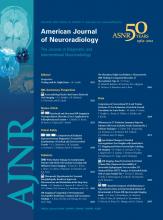We very much appreciate the comments of Drs. Ng et al in response to our article “CT Fluoroscopy-Guided Cervical Interlaminar Steroid Injections: Safety, Technique, and Radiation Dose Parameters.”
Dr. Ng and colleagues question the necessity of CT guidance given the large number of successful injections they have performed under conventional fluoroscopic (CF) guidance, and suggest that injection above the C7-T1 level can be safe under CF guidance. We do not doubt that such procedures can be performed safely in experienced hands. Many authors would disagree with this opinion, however.1⇓⇓–4 Such authors cite a number of anatomic and technical reasons for their objections, as summarized in our manuscript, which may be overcome by using CT fluoroscopy (CTF). Nevertheless, the purpose of our article is not to advocate for 1 type of image guidance over another, because comparative safety and effectiveness data have not been established. Any position taken on this issue would be based on opinion (ie, level 5 evidence), at best. Nor is it our intent to supplant CF guidance for those interventionalists who successfully use it to perform injections, but rather to provide an alternative method for those with reservations about the safety of the procedure.
We fully agree with Dr. Ng and colleagues that radiation dose must be closely scrutinized with any procedure. We take issue with the dose estimates they propose, however. Dose comparison between CF and CTF is not straightforward, due to narrow beam collimation and scan lengths of <1 cm used with CTF. In CT, conversion factors have been used to convert dose-length product to effective dose (ED), but these are not reliable when scan lengths of less than 2 cm are used, and can result in the incorrect estimation of ED by up to a factor of 30.5 For this reason, estimates based on phantom studies may be more reliable. A direct comparison of lumbar CF and CTF guided injections at our institution using an anthropomorphic phantom demonstrated that the ED from the CTF portion of a lumbar injection was half that of the ED for the same procedure performed with CF.6 Ultimately, the small differential risk of radiation-related cancer induction between procedures must be balanced against any potential safety benefit related to the procedure, which as yet remains undetermined. Such overall safety comparisons are therefore premature.
Next, the authors argue that injection at C7-T1 is equivalent to injections at higher cervical levels, though the authors admit that despite this argument they do perform injections as high as C2–3 when anatomy permits. One may speculate as to the validity of this assertion, which is based on indirect evidence, and whether the delivered concentration of injected steroid medication is really equivalent when it reaches a level by remote epidural spread as opposed to direct injection. In the end, though, we are not aware of any study that directly addresses the fundamental question of clinical outcomes using these 2 different approaches.
As for the potential for mixed injection into an epidural vein and the epidural space, we have observed no adverse events to date involving such an injection in several hundred cervical interlaminar epidural steroid injections and several thousand lumbar interlaminar epidural steroid injections.
Drs. Ng et al nicely highlight several topics related to cervical steroid injections where there is insufficient evidence to draw firm conclusions. We believe that these questions will be best addressed with further investigation rather than opinion. The fact that these issues are unresolved, however, does not detract from the primary purpose of our manuscript, which was to report our initial experience with a technique that may have potential advantages—and potential drawbacks—compared with CF, as a basis for future experience.
- © 2012 by American Journal of Neuroradiology











